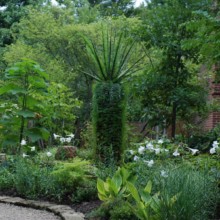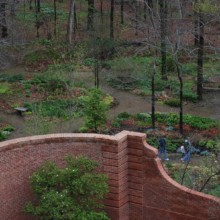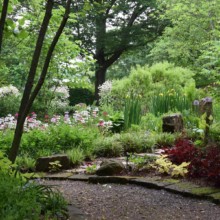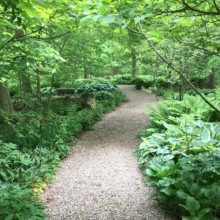Woodland Garden and Trails
What is today known as the Woodland Garden was once the site of a menagerie of kept animals for educational purposes. It was also a classroom of sorts with tree stumps arrayed as chairs. Trails were cut through the woodlands to the west and north of Kingwood Hall and used for the teaching of natural history.
Eventually the Woodland Garden site became a shade garden. As a shade garden it also had an evolution in form. In the 1990’s unnamed daylilies and hostas dominated the garden. They were gradually removed in favor of a wide diversity of shade growing plants such as you see today. Our first rain garden was installed in this garden and most recently a newly improved accessible path has been added.
In the early days of Kingwood there was less of a specialization in horticulture. For example, a naturalist was employed until about the 1980’s. The site of today’s Woodland Garden was an outdoor classroom used by the naturalist. Part of the naturalist’s public offerings was a wildlife collection used for teaching in this outdoor classroom.
The naturalist also tried to introduce wildflowers to the woodland paths. Although the success rate was apparently very low, we don’t know whether some of our many wildflowers along the trails are the result of deliberate planting or are naturally occurring native plants.
The outdoor classroom was eventually transformed into a shade garden in which there did not seem to be a clear or consistent planting plan, although many interesting shade plants found their way into the garden.
Water runoff from the Kingwood Hall forecourt ran through the garden, causing horticultural challenges. In the early 2000’s Kingwood’s first rain garden was constructed to catch the runoff and to create special wetland gardens. Japanese primrose, and a stately iris hybrid between yellow flag iris and Japanese iris are a couple of particularly distinctive residents of this rain garden.
The Garden Gateway project not only brought a new visitor center, parking lot, nature pond, and gardens; it also expanded the accessibility of the property. As part of that effort a new graded path was cut through a portion the woodland garden to allow better access to the garden and to areas beyond.





